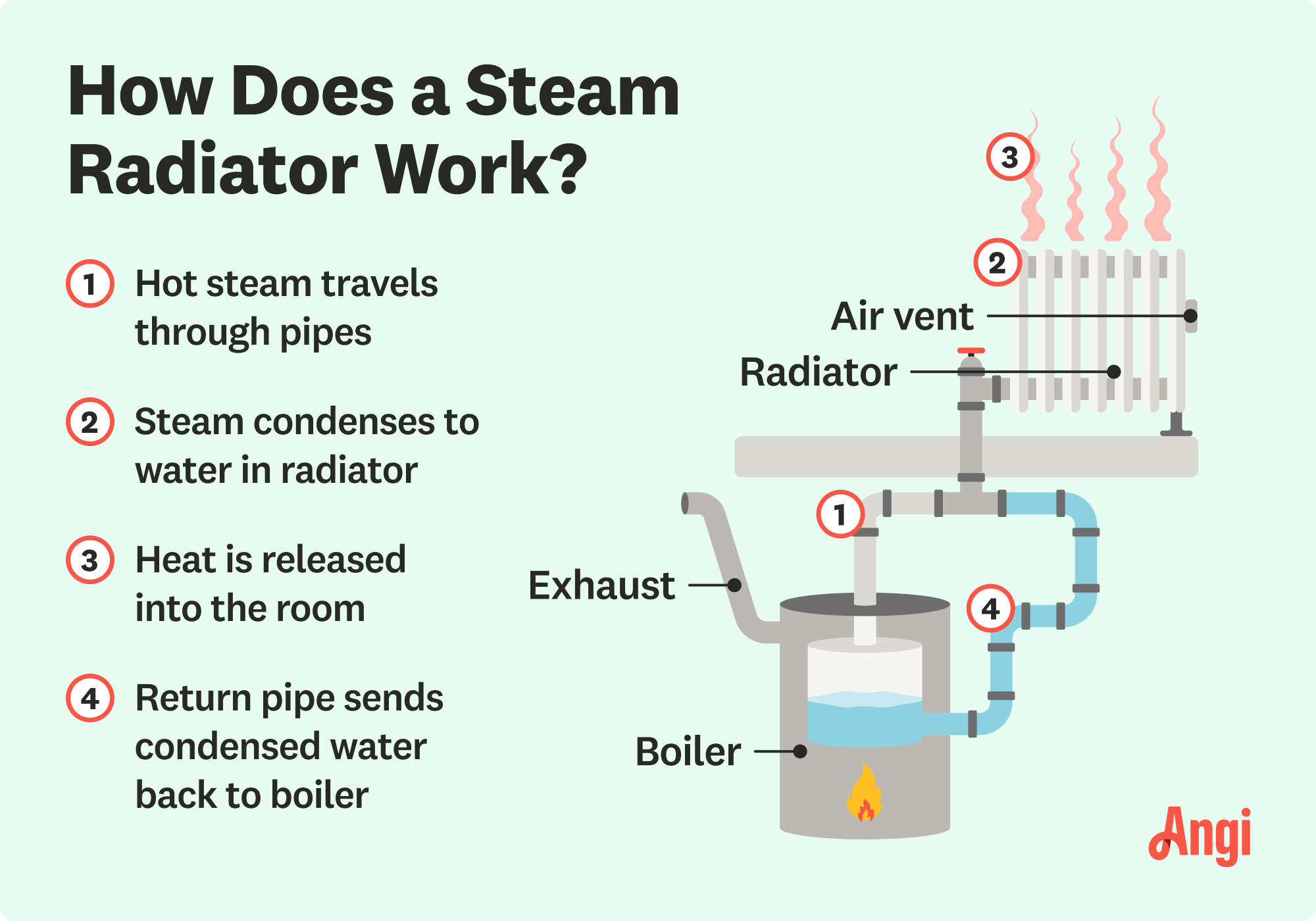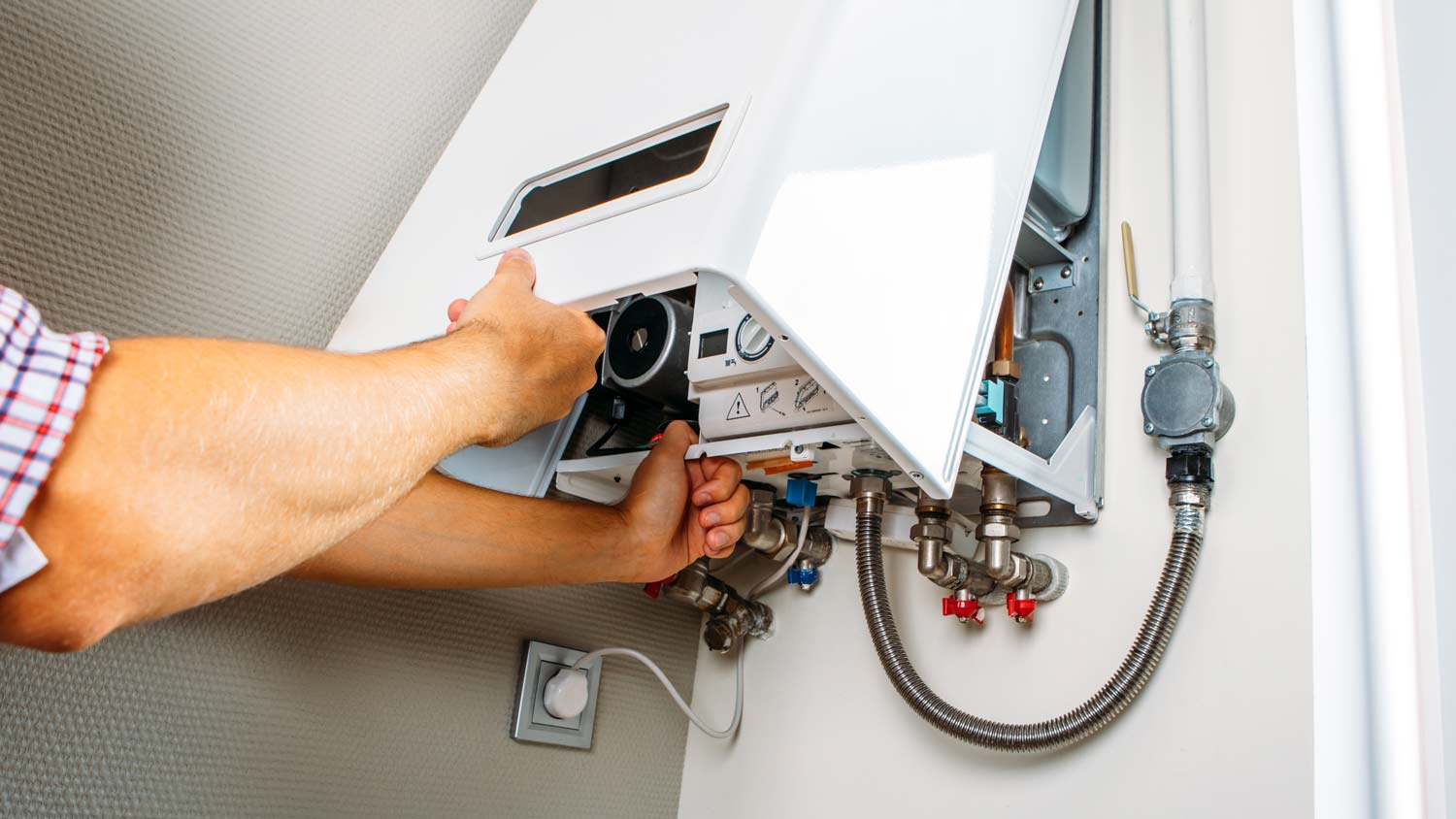
Springing for HVAC maintenance costs may seem like an extra—and easy-to-ignore—item on your checklist, but it will save you money in the long run.
Heating and air conditioning service costs depend on your project and location. Check with a local pro for your specific job.
Prices vary based on a radiator’s energy source, with steam radiators being the most expensive at up to $2,500.
The most expensive styles are freestanding, column, tower rail, and dual-panel radiators, starting at $200.
Stainless steel radiators, which cost from $400 to $1,000, are more expensive than cast iron models.
Repairing a radiator is less expensive than replacing it, costing between $100 and $500 on average.
HVAC specialists charge $100 to $150 per hour to install a radiator.
Radiator replacement costs anywhere from $100 to $2,500 per unit or $1,500 on average, with cost factors boiling down to the capacity, type of unit, and labor. Even the most durable radiator can go on the fritz, turning your home into an icebox come winter. Here’s everything you need to know about radiator replacement costs to make the best decision for your home—and wallet.

The cost to replace a radiator unit varies depending on the type of radiator, the material, the style, the size, labor costs, and whether you need a new boiler.
The type of radiator you choose plays one of the most prominent roles in the total price tag. Steam radiators fall on the highest point in the price range, while hot water radiators come in towards the lower end of the price range. Here’s a breakdown of the different types of radiators.
| Radiator Type | Description | Average Cost |
|---|---|---|
| Hot water | Comes in a one-pipe or two-pipe system | $100–$1,000 |
| Electric | Requires electrician to install and connect wiring and thermostat | $200–$1,500 |
| Steam | Costly new pipes and valves needed, longest life span | $300–$2,500 |
Your radiator’s material also impacts the price, costing anywhere from $200 to $1,000. Conventional cast iron radiators generally cost less than stainless steel radiator systems.
Cast iron radiators: $200–$700
Stainless steel: $400–$1,000
Radiators come in various styles, with prices ranging from as little as $65 to as much as $1,500. Here’s a breakdown of the different price ranges by style.
| Radiator Style | Description | Average Cost |
|---|---|---|
| Baseboard | Lowest price, no steam option | $65–$1,000 |
| Single-panel | Not a lot of heat output, good for small rooms | $80–$300 |
| Flat-panel | Adaptable to all room shapes and sizes | $80–$300 |
| Freestanding | Portable, can be moved to any room | $200–$1,200 |
| Column | Great for rooms with high ceilings and limited wall space | $200–$1,200 |
| Towel rail | Convenient option that enhances comfort | $200–$1,200 |
| Dual-panel | More effective heating than single-panel, most costly | $300–$1,500 |
The size of your radiator impacts the total price, with larger homes needing more radiators than smaller homes.
| Plumbed Radiator Size (BTUs) | Average Cost |
|---|---|
| 3,000 BTUs | $200–$350 |
| 5,000 BTUs | $350–$500 |
| 7,000 BTUs | $500–$700 |
| 10,000 BTUs | $600–$1,000 |
| 12,000 BTUs | $600–$1,200 |
To determine the right-sized unit for systems using BTUs, you will need to figure out the cubic volume of your space by multiplying its width, length, and height. Then, you’ll need to adjust for factors like room size and any other temperature-affecting room features (i.e., outside walls, windows, insulation installed, etc.).
Once you’ve got the final calculation for your BTU requirements, you can determine the radiator size you need. As you might expect, larger radiator sizes tend to cost more.
On average, adding radiators to three standard-sized rooms requires 10 to 15 radiators, which costs between $15,000 and $22,500. Most homeowners opt for heating key areas of their homes with a radiator rather than their whole house.
Below is a chart to help you calculate the number of radiators you’ll need to effectively heat areas of your home.
| Room | Number of Radiators | Average Cost |
|---|---|---|
| Living room | 5 | $500–$12,500 |
| Dining room | 5 | $500–$12,500 |
| Kitchen | 3 | $300–$7,500 |
| Bedroom | 4 | $400–$10,000 |
| Bathroom | 1 | $100–$2,500 |
| Office space | 3 | $300–$7,500 |
Electric radiators use watts to determine the correct sizing for your home. In order to figure out what size electric radiator you need, you’ll have to figure out the cubic volume of your space, just like we reviewed above (multiply length, width, and height, and factor in room features).
This will give you your space’s BTU requirements. To convert this number to watts so you can match it to an appropriate electric radiator, you simply need to divide the BTU number by 3.41.
Here’s a breakdown of new electric radiator costs by watts.
| Electric Radiator Size (Watts) | Price Range per Unit |
|---|---|
| 400 Watts | $100–$500 |
| 600 Watts | $300–$700 |
| 800 Watts | $600–$1,000 |
| 1,000 Watts | $900–$1,500 |
HVAC labor costs to install a radiator typically range between $100 and $150 per hour. Because installing a new radiator can be a complicated process, it requires the skills of an HVAC specialist.

If you’re installing a new radiator system or need to replace your current system completely, you may have to purchase a new boiler, too. Boilers range from $580 to $12,000. Labor costs to install a new boiler range between $1,500 and $2,500. A boiler installer near you can also repair a boiler for between $200 and $600.
Plumbed and electric radiator systems require the expertise of a professional to do the job correctly. Unless you have experience installing radiators, you shouldn’t attempt to DIY it. If you do have experience, you’d only have to pay for the cost of the radiator itself. So your cost will vary based on the number of radiators you need, as well as the style and material. You’ll likely pay between $65 on the lowest end to DIY, and $1,500 on the high end. You’ll save between $100 and $800 on installation costs if you install a radiator yourself.
Plumbed radiators take around three to four hours to install, while electric units take around two to three. You’ll end up spending anywhere from $200 to $800 to have a pro install a plumbed system and $100 to $600 to install an electric radiator.
Again, it’s best to leave the installation to the pros. An HVAC technician near you has the skills needed to handle the potentially hazardous installation.
Most radiators last at least eight years. If your radiator is only a few years old, you should consider repairing it instead of replacing the entire unit. The cost to repair a radiator is between $100 and $500, which saves you $1,000 to $1,400 if the cost to replace your unit is the average price of $1,500.
Here are the most common radiator repair problems and their estimated costs.
| Repair | Average Cost |
|---|---|
| Radiator bleeding | $100–$200 |
| Stopping a leak | $150–$600 |
| Fixing a clog | $200–$450 |
| Repairing a crack | $175–$400 |
Home is the most important place on earth, which is why Angi has helped more than 150 million homeowners transform their houses into homes they adore. To help homeowners with their next project, Angi provides readers with the most accurate cost data and upholds strict editorial standards. We extensively research project costs to develop the pricing data you see, so you can make the best decisions for you and your home. We rely on reputable sources, including the U.S. Bureau of Labor Statistics, academic journals, market studies, and interviews with industry experts—all to ensure our prices reflect real-world projects.
Want to help us improve our cost data? Send us a recent project quote to [email protected]. Quotes and personal information will not be shared publicly.
From average costs to expert advice, get all the answers you need to get your job done.

Springing for HVAC maintenance costs may seem like an extra—and easy-to-ignore—item on your checklist, but it will save you money in the long run.

What you’ll pay in Columbus, OH, for furnace repairs depends on many factors. Here’s a breakdown of what can go wrong and the cost to fix those issues.

Discover the primary whole-house air filtration system cost factors when installing one in your home to help remove airborne contaminants and allergens.

If you need to repair a gas boiler or radiator heating system, you should first talk to a pro. Here are the top radiator repair questions you should ask.

Do you have a clogged AC drain line? We dig into the reasons behind those pesky blockages and how to clear them for optimal AC performance.

If you’re thinking about an alternative to a traditional HVAC system, you may want to consider a heat pump. Read on for more about heat pump systems.